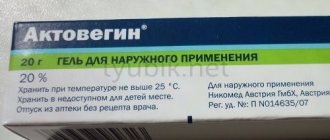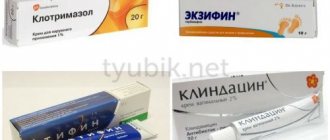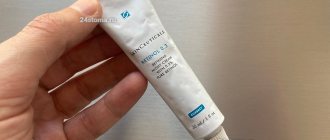Drapolene cream 55g No. 1
Name
Drapolene cream dnar.approx. in tubes 55g per pack. No. 1
Description
A homogeneous cream of pink color, small, more intensely colored inclusions are possible.
Main active ingredient
benzalkonium chloride solution 0.2 mg (equivalent to 0.1 mg/g benzalkonium chloride), cetrimide 2.0 mg.
Release form
55.0 g of cream in a laminated tube (polyolefin/foil/polyolefin) with high-density polyethylene “hangers” with a screw-on plastic cap. 1 tube along with instructions for use in a cardboard box.
Dosage
55g
pharmachologic effect
Antiseptic and disinfectants. Quaternary ammonium compounds. ATX code: D08AJ
Pharmacodynamics
Benzalkonium chloride and cetrimide are quaternary ammonium compounds with properties characteristic of cationic surfactants. This drug is useful for the treatment and prevention of diaper dermatitis, due to the fact that Drapolen™ inhibits the development of microorganisms that contribute to the development of diaper dermatitis.
Pharmacokinetics
There are no data on the pharmacokinetics of the active ingredients, cetrimide and benzalkonium chloride, when used as prescribed. Systemic absorption of the active components is unlikely.
Indications for use
Treatment of diaper dermatitis, prevention of diaper dermatitis as an addition to hygienic child care. The drug is also used to relieve symptoms of small superficial burns (limited to the epidermis), small sunburns and the effects of exposure to weather conditions on the skin.
Directions for use and doses
For external use only. Adults (including elderly patients) Before applying Drapolene™, thoroughly wash and dry the affected area. To achieve optimal results, remove any remaining soap from the area where the cream is applied. The cream is applied evenly in a thin layer to the affected area several times a day (as needed). Newborns, infants and children Whenever you change a diaper or diaper, thoroughly wash and dry the area covered by the diaper or diaper. To achieve optimal results, remove any remaining soap from the area where the cream is applied. The cream is applied evenly in a thin layer to the affected area after each diaper change, paying special attention to skin folds. Patients with impaired renal function No special precautions are required. Patients with impaired liver function No special precautions are required.
Use during pregnancy and lactation
Special precautions are not required when using the cream in accordance with the instructions for use during pregnancy and breastfeeding, since systemic absorption of the drug components is unlikely.
Precautionary measures
The cream should be stored out of the reach of children. If you accidentally swallow the cream, consult a doctor. Avoid getting the cream in your eyes or contact lenses. If diaper rash does not go away within 48-72 hours, you should consult a doctor.
Interaction with other drugs
No reports of drug interactions have been received.
Contraindications
Drapolene™ is contraindicated in patients with a history of hypersensitivity to benzalkonium chloride, cetrimide, lanolin or excipients included in the drug. If a hypersensitivity reaction occurs, discontinue use of the drug.
Compound
Active ingredients in 1 g: benzalkonium chloride solution 0.2 mg (equivalent to 0.1 mg/g benzalkonium chloride), cetrimide 2.0 mg. Excipients: white soft paraffin, anhydrous lanolin, cetyl alcohol, polyvax GP 200, chlorocresol, carmoisine E 122, purified water.
Overdose
Overdose is unlikely due to the low concentration of benzalkonium chloride and cetrimide in the drug, however, in case of accidental ingestion, consult a doctor and undergo symptomatic treatment.
Side effect
Skin and subcutaneous tissue disorders: contact dermatitis, local skin reactions. The frequency of these reactions is unknown. Immune system disorders: allergic reactions, skin reactions of immediate or delayed hypersensitivity. The frequency of these reactions is unknown. Patients with sensitivity to one or more components of Drapolen™ cream may experience allergic hypersensitivity reactions. There are rare reports of hypersensitivity to lanolin. In isolated cases, some patients who used an ophthalmic solution that uses benzalkonium chloride as a preservative experienced swelling and conjunctivitis. Cases of contact dermatitis have been reported with the use of benzalkonium chloride in plaster casts. Hypersensitivity to cetrimide may occur in the form of localized contact dermatitis; in severe cases, the rash may become generalized. If the listed adverse reactions occur, as well as reactions not mentioned in the instructions for medical use, you should consult your doctor.
Storage conditions
Store at a temperature not exceeding 25 °C. Keep out of the reach of children.
Dermatitis: which cream to choose?
This problem causes discomfort and, in some cases, fear and confusion. Symptoms of dermatitis can affect not only your health, but also your work and personal life. It causes particular concern among young parents, like any illness in the baby.
Dermatitis is usually called any kind of manifestation on the skin that differs from its normal state: redness, peeling, itching, and so on.
If any changes occur, consult a specialist. It is worth noting that 10% of all visits to a dermatologist are related to manifestations of dermatitis. Women apply more often due to greater contact with household chemicals.
Types of Dermatitis
There are two main groups of dermatitis: contact and allergic.
The manifestations of contact dermatitis are:
Acute - the onset is rapid after a single interaction with substances that have a pronounced irritant effect.
Chronic - develops gradually with constant contact with an irritant over several days or even years. In this case, the cause will be mild irritants such as: household chemicals, soap solutions, dry air, dust.
Allergic dermatitis is a manifestation of a malfunction of the body's immune system to one or more irritants, manifested by inflammation.
The most common places of manifestations:
- Skin of hands
- Face
- Neck
- Armpits
- Scalp
- Anogenital area, most often in children.
- Ears
- Shin
- Feet
The manifestations of acute contact and allergic dermatitis are very similar: redness, swelling and rashes in the form of bubbles and blisters and “pimples”. Itching, burning, and soreness of the skin will also be felt. With allergic dermatitis, the manifestations will not be limited to the place of skin contact with the irritant; the reaction goes far beyond its limits. As a result, mandatory consultation with a specialist is necessary to confirm the correct diagnosis and treatment.
In chronic dermatitis, the lesions do not look as bright as in acute dermatitis, but also have swelling, which can be accompanied by: cracks, hyperpigmentation and damage to the integrity of the skin, the desire to scratch and pinch it. Even after eliminating the impact of the irritant, the process can continue for up to several months.
To make an accurate diagnosis, the doctor will need to tell you in detail how, when and after what the skin lesion occurred. Skin tests will also be performed.
Dermatitis is usually called any kind of manifestation on the skin that differs from its normal state.
Treatment
The main goal of treatment is to return the person to the previous comfort and condition of the skin. The priority in the treatment of contact dermatitis is to identify the irritating factor and eliminate it. If it is impossible to eliminate contact, for example, due to professional necessity, adequate and reliable skin protection must be selected (overall clothing, gloves, protective creams and ointments). For simple contact dermatitis, the effectiveness of hormonal ointments and creams is not enough. The effectiveness of the use of selective alcineurin inhibitors tacrolimus and pimecrolimus for the types of dermatitis indicated in the article has not been proven in controlled studies.
In case of severe itching, it is possible to use antihistamines - Zodak, Claritin, Xestin, Erius, Suprastinex, Dizal, Alegra, Xyzal, Fenistil.
Local treatment:
- Cutivate (fluticasone propionate) cream, ointment for 2 weeks
- Triacort, Fluorocort (triamcinolone acetonide) ointment 0.025%, 0.1% for 2 weeks, treatment must begin with a higher dose
- Dermovate, Clobetasol, Psoriderm, Dilasen, Powercourt (clobetasol propionate) ointment for 3–4 weeks
- Akriderm, Beloderm, Celestoderm (betamethasone valerate) cream, ointment 2 weeks
- Uniderm, Elokom, (mometasone furoate) cream, ointment 0.1% 2 weeks
It happens that a bacterial infection can join the course of the underlying dermatitis. In this case, it is worth connecting additional local antibacterial therapy:
- Fucidin (fusidic acid) cream, gel 2% for 1–2 weeks
- Supirocin, Bactroban (mupirocin) ointment 2% for 2 weeks
If there is no result in the treatment of allergic dermatitis, it is possible to use immunosuppressive drugs cyclosporine, azathioprine. Application of UV-B or PUVA therapy.
Prevention of dermatitis is the understanding that this reaction is lifelong and even short-term contact should be avoided.
Reminder for hand skin care for occupational contact dermatitis:
- Be sure to wear gloves
- Use soap substitutes. Soap removes the protective fatty layer of the skin and damages the stratum corneum of the skin, which retains water, thereby greatly increasing permeability to any substances. In addition, some soap components themselves are irritating.
- Avoid Potentially Irritating Substances
- Follow your doctor's recommendations for at least six months
- Do not wear rings as they are a place where irritants accumulate, and if a person is still not ready to give up wearing them, then it is necessary to remove them while working and doing household chores.
- Also regularly use emollients - these are substances similar in composition to the natural protective fatty film of the skin, affecting the upper layers of the skin. They are: natural, chemical, synthetic.
Available daily care products that can be purchased at any pharmacy: Bepanten, Tipikrem, Emolium, Mustela, Lipobase, La-cree.
For adults only: Lokoid, Dermovate, Sinalar. They should only be applied to clean, dry skin.
One of the new directions is the use of corneoprotectors. These are products that restore the integrity of the stratum corneum directly. Physiogel, Oilatum, Lipikar, Protopic.
By self-medicating, you can cause irreparable harm to your health; be sure to consult a doctor and follow his recommendations.
Literature: Federal clinical guidelines for the management of patients with contact dermatitis, Moscow - 2015


